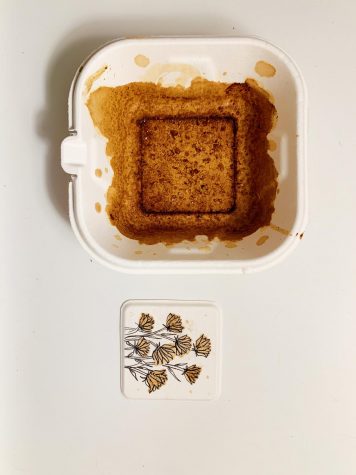Student Spotlight: UI student uses dining hall to-go containers to create watercolor-like works of art
Fourth-year UI student Ericka Barloon uses the materials from her to-go meals to create art and reduce waste.
Portrait of Ericka Barloon taken on Tuesday, Sept. 22, 2020 in the courtyard between Currier and Stanley residence halls. Barloon is a senior RA this year.
September 22, 2020
After finishing their takeout from University of Iowa dining halls, most students see the paper to-go boxes provided to them as trash and throw them in their waste bins without a second thought. Fourth-year student Ericka Barloon, however, sees an opportunity to create art.
For as long as she can remember, Barloon has been an artist. The music-education major won several art contests in high school for her oil paintings, and her mother even has framed paintings she made when she was three years old. Barloon has also been a singer all her life, and starred as Beth March in the UI’s production of Little Women Opera when she was only a sophomore.
As a full-time college student and Resident Assistant in Burge Hall, Barloon has less time to devote to her artistic hobbies, but still loves working with oil paintings, photography, and most recently, flowers using recycled materials.
Generally, Barloon paints humans, specifically dancers — which are some of her favorite subjects. Her primary subject matter switched to flowers, however, when she started using leftovers to make art because of the food’s coloration. The artist said she uses the leftover color for “paint” and the white compostable paper take-out containers as a canvas.

 “I got a bunch of raspberries one day and there was all this pigmented juice left over and I thought, ‘Well, I could make something. Might as well not throw it away,’” she said.
“I got a bunch of raspberries one day and there was all this pigmented juice left over and I thought, ‘Well, I could make something. Might as well not throw it away,’” she said.
In addition to raspberries, Barloon has used soy sauce, mustard, and salsa for coloration. She said art and recycling both make her feel good about herself.
“I feel so capable doing art,” Barloon said. “It’s such a cool skill that not everybody has. I really like working with hard and fine details and getting to see what you made when you’re done.”
With recycling no longer an option in the residence halls, Barloon said she’s glad she found a way to reduce waste. Her paintings are completely biodegradable.
RELATED: Student Spotlight: UI artist creates music and paintings from themes of liberation of the self
According to Global Citizen, the average American produce 1704 pounds of garbage per year, which is approximately three times the global average. The same report found that only about 16 percent of recyclable materials are actually recycled in the U.S.
Global Citizen also reported that trash is the U.S.’s number one export to China because landfills can’t keep up with the speed that waste is produced. When waste can’t be sent to landfills in the U.S. or exported overseas, it’s often illegally dumped into the ocean.
The UI’s food-waste recycling program LeanPath, reduced food waste by 52 percent last semester — 7 percent short of its goal. With COVID-19 causing substantial changes to the university’s recycling initiative, it’s now more important than ever for students to make an effort to reduce food waste on their own.
While making art out of leftovers may not be the most conventional way to combat climate change, it exemplifies the very kind of creative thinking that can reduce one’s waste.
“It makes me feel a little bit better about the environment,” Barloon said. “I encourage people to reduce and reuse since we don’t have the option to recycle anymore.”






